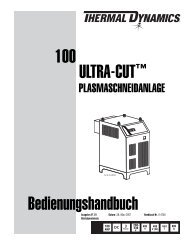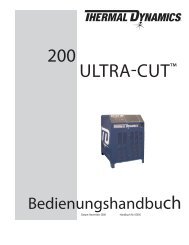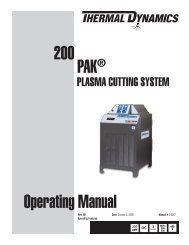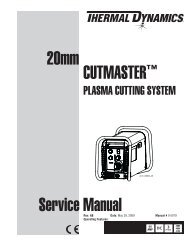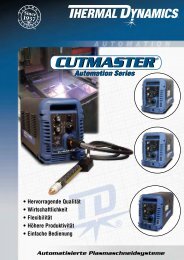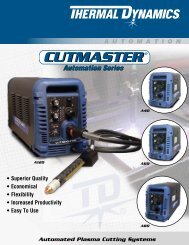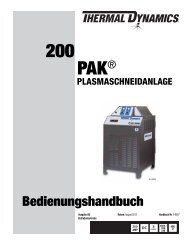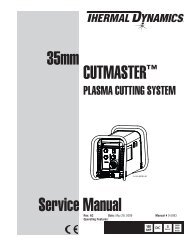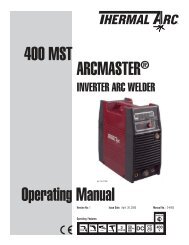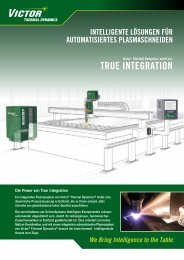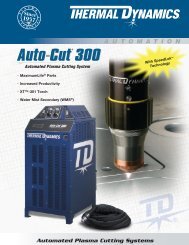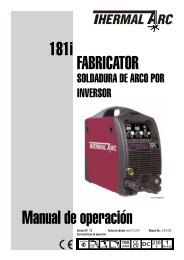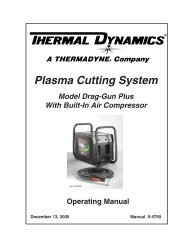211i Operating Manual FabricatOr® - Victor Technologies - Europe
211i Operating Manual FabricatOr® - Victor Technologies - Europe
211i Operating Manual FabricatOr® - Victor Technologies - Europe
Create successful ePaper yourself
Turn your PDF publications into a flip-book with our unique Google optimized e-Paper software.
FABRICATOR <strong>211i</strong> BASIC WELDING<br />
4.04 STICK (MMA) Welding Troubleshooting<br />
FAULT CAUSE REMEDY<br />
1 Welding current<br />
varying<br />
2 A gap is left by<br />
failure of the weld<br />
metal to fill the<br />
root of the weld.<br />
3 Non-metallic particles<br />
are trapped<br />
in the weld metal.<br />
Insufficient Gap<br />
4 A groove has been<br />
formed in the base<br />
metal adjacent to<br />
the toe of a weld<br />
and has not been<br />
filled by the weld<br />
metal (undercut).<br />
ARC FORCE control knob<br />
is set at a value that<br />
causes the welding current<br />
to vary excessively with<br />
the arc length.<br />
Reduce the ARC FORCE control knob until welding<br />
current is reasonably constant while prohibiting<br />
the electrode from sticking to the work piece<br />
when you “dig” the electrode into the workpiece.<br />
A Welding current too low A Increase welding current.<br />
B Electrode too large for<br />
joint.<br />
B Use smaller diameter electrode.<br />
C Insufficient gap. C Allow wider gap.<br />
A Non-metallic particles may<br />
be trapped in undercut<br />
from previous run.<br />
B Joint preparation too<br />
restricted.<br />
C Irregular deposits allow<br />
slag to be trapped.<br />
D Lack of penetration with<br />
slag trapped beneath weld<br />
bead.<br />
E Rust or mill scale is preventing<br />
full fusion.<br />
F Wrong electrode for position<br />
in which welding is<br />
done.<br />
Art # A-05866_AC<br />
Incorrect Sequence<br />
A Welding current is too<br />
high.<br />
A If a bad undercut is present clean slag bout and<br />
cover with a run from a smaller gauge electrode.<br />
B Allow for adequate penetration and room for<br />
cleaning out the slag.<br />
C If very bad, chip or grind out irregularities.<br />
D Use smaller electrode with sufficient current to<br />
give adequate penetration. Use suitable tools to<br />
remove all slag from comers.<br />
E Clean joint before welding.<br />
F Use electrodes designed for position in which<br />
welding is done, otherwise proper control of slag<br />
is difficult.<br />
Figure 1-Example of insufficient gap or incorrect sequence<br />
A Reduce welding current.<br />
B Welding arc is too long. B Reduce the length of the welding arc.<br />
C Angle of the electrode is<br />
incorrect.<br />
D Joint preparation does not<br />
allow correct electrode<br />
angle.<br />
E Electrode too large for<br />
joint.<br />
F Insufficient deposit time at<br />
edge of weave.<br />
G Power source is set for<br />
MIG (GMAW/FCAW)<br />
welding.<br />
C Electrode should not be inclined less than 45° to<br />
the vertical face.<br />
D Allow more room in joint for manipulation of the<br />
electrode.<br />
E Use smaller gauge electrode.<br />
F Pause for a moment at edge of weave to allow<br />
weld metal buildup.<br />
G Set power source to STICK (MMA) mode.<br />
BASIC WELDING GUIDE 4-20 <strong>Manual</strong> 0-5225



